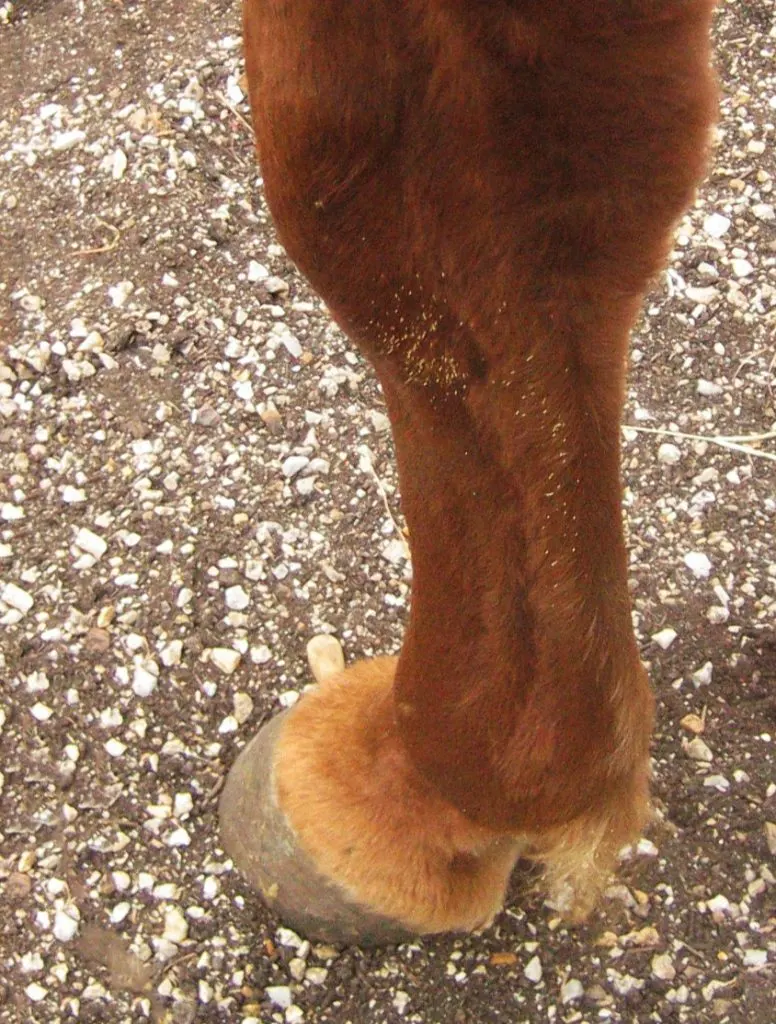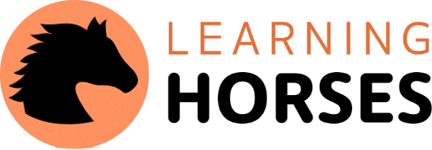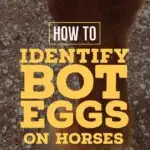Bot eggs look like small yellow specks on your horse’s coat. Botflies, the cause of these spots, usually lay their eggs on the inside of a horse’s legs. Although the inside of a horse’s legs is the most common location to find bot eggs, the eggs (which look like small yellow specks) can show up anywhere on a horse’s body.
Typically, bot eggs are laid in clusters, as shown here, but may be more evenly distributed on the legs, body, or even face. Different species of botflies lay their eggs on different parts of the horse’s body.

The botfly reproduces by laying eggs on horse legs and waiting for the horse to ingest them when the horse rubs its face on their legs.
Once you know how to recognize them, it’s a good idea to remove them if you see the eggs on your horse. The female bot fly can lay between 150-500 eggs in her 7-10 day life cycle, so in heavily bot fly infested areas like the American midwestern and northern states, this can feel like a big job!
When to be Concerned about Bot Eggs
Just like managing bald patches and tail rubbing, bot eggs typically aren’t a significant problem if they are monitored, removed, and managed.
The eggs of the bot fly are what we are more concerned with, since they contain the bot larvae that can be dangerous to your horse’s digestive tract. . What’s most important is that the eggs are removed promptly, before the horse licks them and the larvae are allowed to enter the mouth and start causing problems.
sampson.ces.ncsu.edu
The eggs on the legs are stimulated to hatch by the lip action and warm saliva as the horse licks its leg. (source)
Ingesting bot eggs is believed by some veterinary researchers to cause minimal danger to horses (source) some clinical resources argue that severe infestations in a horse’s stomach can present a risk of colic. Bot eggs can cause health problems, you should not be alarmed if you find them on your horse- controlling bot eggs is a normal part of horsekeeping and grooming.
Danger to Humans
Rare, but possible, humans are susceptible to burrowing larve hatched from bot fly eggs.
In this case, hatching larvae enter the skin of humans and begin burrowing through the skin causing visible, sinuous, inflamed tracks accompanied by considerable irritation and itching (Catts and Mullen 2002).
(source)
To prevent this rare human form of botfly infection, wash your hands after grooming your horse and removing botflies.
Preventing Bot Fly Eggs
Administering an anthelmintic, or dewormer, in the late summer and again after the first killing frost will kill the internal larvae and help break the cycle at that stage.
Read more about preveting at: https://union.ces.ncsu.edu/2020/09/protecting-your-horse-from-botflies/
How to Remove Bot Eggs
The best tool to remove bot eggs are blade-protected horse-safe razors. If a Horse Shave razor is not available, a pumice or lava-like grooming stone or a specially made knife (meant for removing bot eggs from horse fur) also will work. Even if you diligently clean bot eggs off the horse’s body you should deworm your horse with a full spectrum wormer regularly to kill any bot eggs that your horse may have accidentally ingested.
The photo above shows what bot eggs look like on a typical horse. Bot eggs stand out and are easy to spot on dark colored horses and on the legs of this chestnut mare. If you have a light colored horse such as a grey horse, palomino, a white mare or gelding, or a horse with high leg markings, you will need to be more diligent about checking for bot eggs during regular grooming. On light fur these eggs may blend into the color of your horse’s coat, however this is not as much of a concern for black horses or chocolate palominos.

